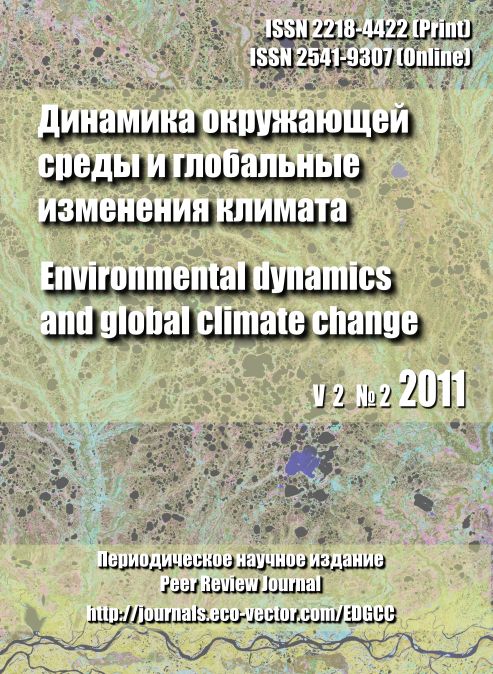Vol 2, No 2 (2011)
- Year: 2011
- Published: 15.12.2011
- Articles: 3
- URL: https://edgccjournal.org/EDGCC/issue/view/387
Articles
Inventory of soil methane consumption
Abstract
On the basis of the various rates measured for a wide variety of soils, global soil methane oxidation ranges between 5 and 60 Tg/year. These values are approximately 1 to 10% of the current estimates for net methane flux to the atmosphere [Dörr et al., 1993]. Methane uptake by soils is an appropriate process to model globally because the probable controls are simple relative to many other microbially mediated soil processes of trace gas production and consumption [Potter et al. , 199 6 ]. Potential microbial decomposition rate, vegetation cover, soil temperature , organic matter content, pH [Born et al., 1990; Dörr et al., 1993] as well as latitude, annual mean rainfall, and annual mean temperature [ Dutaur and Verchot, 2007 ] are found to be of minor influence on the methane flux from the atmosphere into the soil. Principal methods of gas flux upscaling such as simplest inventory, using of mathematical models and inverse modelling are described in this study by an example of methane uptake by soils. Different implementations of simplest inventory approach as CH 4 uptake estimation in soils of various bioms and/or structure are considered. Methane consumption in aerated soils is mainly controlled by the gas transport resistance within the soil as it was found by Born et al. [1990] and Dörr et al. [1993]. However this assertion is seemed to be correct only for similar bioms or at local areas. Th e inventory of Dutaur and Verchot [ 2007 ] showed that ecosystem type, geographic zone, and soil texture strongly control CH 4 uptake. The ecosystem type accounted for the largest part of the variation in the global data set while established uptake estimation approach based on our knowledges about soil structure is proved to be statistically unreliable at significance level 0.05 (usually used in biometric and pedometric studies). At the final section simplest inventory approach applied to the methane uptake by Russian soils is discussed. It was shown that consumption estimations obtained for Russian soils vary considerably according to the different studies. This heterogeneity indicates significant gaps in our knowledge of methane emission and consumption in Russian soils and necessity of the future research. Probable methane uptake by Russian soils similar to other estimations can be accepted as 3.6 М t/yr. The authors acknowledge the financial support by the European Union FP7-ENVIRONMENT project PAGE21 under contract no. GA282700.
Environmental Dynamics and Global Climate Change. 2011;2(2):1
 1
1


Contribution of palsa to methane emission from West Siberian tundra wetlands
Abstract
Methane flux measurements using static chamber technique were carried out on a palsa site («Yamburg», 67.97° N, 75.4° E) in the south tundra subzone of West Siberia in August 2011. Despite the fact that palsa is the second most common type of wetland microlandscapes in West Siberian tundra, our knowledge about methane fluxes from this microlandscape is still very limited. The mean methane flux value from West Siberian tundra palsas was 0.13 ± 0.29 mgC-СН 4·m -2·h -1. Obtained results were used in the new version (Bc9) of the “standard model” for regional methane fluxes, developed by the authors. It was found that despite the large coverage in the tundra zone of Western Siberia, palsa emits only 1.9 Gg С-СН 4·year -1, or 2% of the regional methane flux from tundra wetlands, estimated as 0.1087 Tg С-СН 4·year -1, which in turn is about 4% of the total methane flux from West Siberian wetlands. We compared CH 4 flux data from two most abundant microlandscapes, palsas and eutrophic hollows, with similar data obtained by other authors over the whole Eurasian tundra. Comparison showed that variations in methane emission rates within each microlandscape are insignificant and can be caused by the interannual variability and different ecological and climatic conditions. Evaluation of different variability types including spatial and temporal variability showed that the uncertainty of obtained fluxes is close to the theoretically expected rate.
Environmental Dynamics and Global Climate Change. 2011;2(2):2
 2
2


Slovo v zashchitu «Ucheniya global'nogo potepleniya», ili o chem povedala nam strelka ostsillografa (retsenziya na stat'yu «Uchenie global'nogo potepleniya» Yu.L. Latyninoy (24 dekabrya 2009 g. internet-gazeta «Ezhednevnyy zhurnal»)
Abstract
Для справки. Ю. Латынина – журналист, и не последний в этом мире. Ее читают и цитируют, дают премии. Работает в «Новой газете», на радио «Эхо Москвы», в двух интернет-изданиях («Газета.ру» и «Ежедневный журнал»), пишет детективы. Ее знают все, или почти все. Поэтому своей главной цели в жизни она добилась. Я это говорю потому, что писать опровержение на опус какого-то никому не известного человека я бы, конечно, не стал. ...
Environmental Dynamics and Global Climate Change. 2011;2(2):3
 3
3











